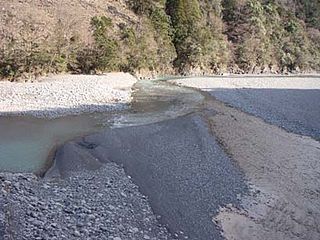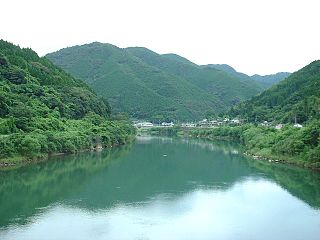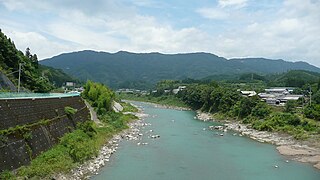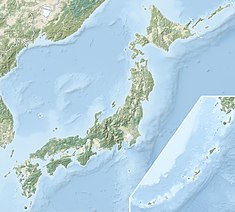
Ibaraki Prefecture is a prefecture of Japan located in the Kantō region of Honshu. Ibaraki Prefecture has a population of 2,871,199 and has a geographic area of 6,097.19 square kilometres. Ibaraki Prefecture borders Fukushima Prefecture to the north, Tochigi Prefecture to the northwest, Saitama Prefecture to the southwest, Chiba Prefecture to the south, and the Pacific Ocean to the east.

Shirakawa is a city located in Fukushima Prefecture, Japan. As of 1 April 2020, the city had an estimated population of 59,393 in 23,546 households and a population density of 190 persons per km2. The total area of the city was 305.3 square kilometres (117.9 sq mi).

The Ōi River is a river in Shizuoka Prefecture, Japan.

The Shinano River, known as the Chikuma River in its upper reaches, is the longest and widest river in Japan and the third largest by basin area. It is located in northeastern Honshu, rising in the Japanese Alps and flowing generally northeast through Nagano and Niigata Prefectures before emptying into the Sea of Japan.

An abutment is the substructure at the ends of a bridge span or dam supporting its superstructure. Single-span bridges have abutments at each end which provide vertical and lateral support for the span, as well as acting as retaining walls to resist lateral movement of the earthen fill of the bridge approach. Multi-span bridges require piers to support ends of spans unsupported by abutments. Dam abutments are generally the sides of a valley or gorge, but may be artificial in order to support arch dams such as Kurobe Dam in Japan.

The Kuma River is a river in Kumamoto Prefecture, central Western part of Kyūshū, Japan. It is sometimes referred as Kumagawa River. It is the longest river in Kyushu, with the length of 115 km long and has a drainage area of 1,880 km2 (730 sq mi). The tidal flat of the Kuma River estuary is approximately 1000 hectares.

South Korean nationality law details the conditions in which an individual is a national of the Republic of Korea (ROK), commonly known as South Korea. Foreign nationals may naturalize after living in the country for at least five years and showing proficiency in the Korean language. All male citizens between the ages of 18 and 35 are required to perform at least 18 months of compulsory military service. North Korean citizens are also considered South Korean nationals, due to the ROK's continuing claims over areas controlled by the Democratic People's Republic of Korea (DPRK).
Bach Collegium Japan (BCJ) is composed of an orchestra and a chorus specializing in Baroque music, playing on period instruments. It was founded in 1990 by Masaaki Suzuki with the purpose of introducing Japanese audiences to European Baroque music. Suzuki still remains its music director. The ensemble has recorded all of Bach’s cantatas, a project that extended from 1995 to 2018 and accounts for over half of its discography.

Saru River is a river in Hokkaidō, Japan.

Mitsuo Iso is a Japanese animator, director, and screenwriter. He began his career as an animator in the mid-1980s and worked as a freelance artist through Neomedia, Studio Zaendo, and Studio Ghibli.

Malampuzha Dam is the largest dam and reservoirs in Kerala, located near Palakkad, in the state of Kerala in South India, built post independence by the then Madras state. Situated in the scenic hills of the Western Ghats in the background it is a combination of a masonry dam with a length of 1,849 metres and an earthen dam with a length of 220 metres making it the longest dam in the state. The dam is 355 feet high and crosses the Malampuzha River, a tributary of Bharathappuzha, Kerala's second longest river. There is a network of two canal systems that serve the dam's reservoir of 42,090 hectares.

The Tenryū River is a river in central Honshū, Japan. With a length of 213 km (132 mi), it is Japan's ninth longest river.

The Shō River has its source in Mount Eboshi in the Shōkawa-chō area of Takayama, Gifu Prefecture, Japan. After flowing for 115 km (71 mi) through the northern part of Gifu Prefecture and the western part of Toyama Prefecture, it empties into Toyama Bay.
Niikappu River is a river in Hokkaidō, Japan.

The Gōnokawa River is a river that runs through Hiroshima and Shimane prefectures in Japan. It is the largest river in the Chūgoku region. It is also called the Gōgawa River and, in Hiroshima, the Enokawa River.

Mimi River is a river of Japan. It flows through the Miyazaki Prefecture. There is cascade of six dams built on the river with two dams in the upstream basin of the Tsukabaru Dam and three dams on the downstream.
Chōsen-seki is a legal status assigned by the Japanese government to ethnic Koreans in Japan who do not have Japanese nationality and who have not registered as South Korean nationals. The status arose following the end of World War II, when many Koreans lost Japanese nationality. Most people with this status technically have both North Korean nationality and South Korean nationality under those countries' respective nationality laws, but since they do not have South Korean documents, and Japan does not recognize North Korea as a state, they are treated in some respects as being stateless.
The National Confederation of Trade Unions, commonly known in Japanese as Zenroren (全労連), is a national trade union center.
Chimako Tada was a Japanese poet renowned for her surreal style and evocation of women's experience in post-war Japan. She authored more than 15 books of Japanese poetry, and also translated prose and poetry from French. Tada wrote in traditional styles, such as tanka and haiku, as well as contemporary prose poetry.














